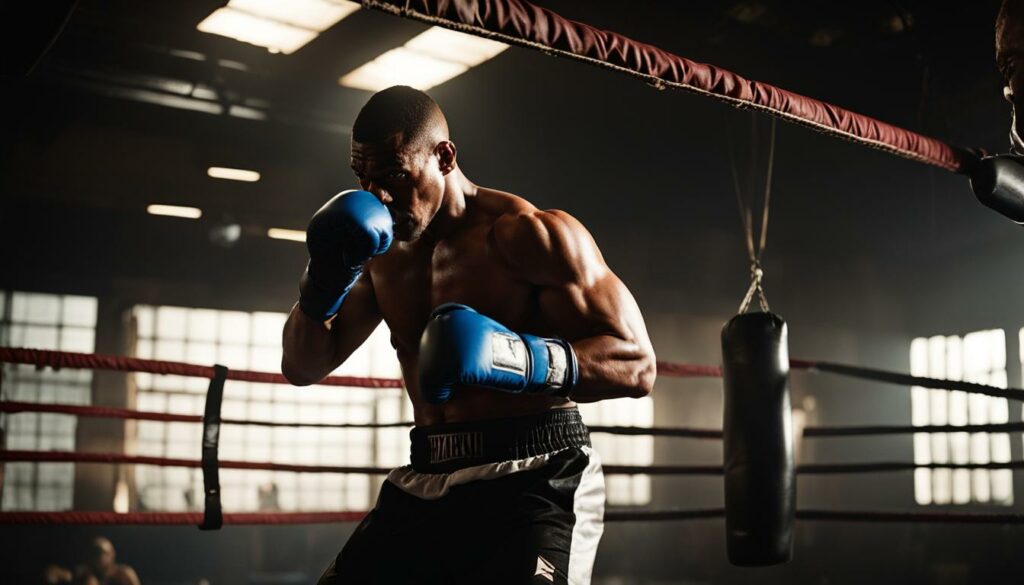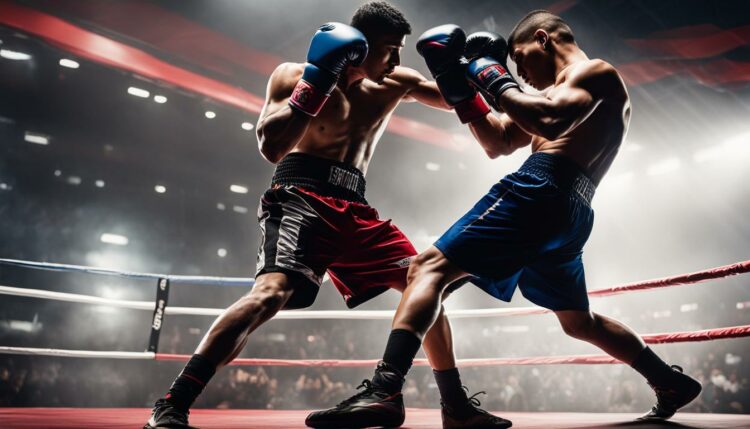Boxing and kickboxing are two popular combat sports that involve striking techniques. While both sports share similarities, they also have distinct differences that make each unique.
When it comes to self-defense, both boxing and kickboxing can be effective. Boxing primarily focuses on punches, while kickboxing allows the use of both punches and kicks. This difference gives kickboxers a wider range of attacks compared to boxers.
In terms of techniques, boxing emphasizes powerful punching combinations. Boxers are renowned for their ability to throw rapid and accurate punches, utilizing techniques such as jabs, hooks, crosses, and uppercuts. On the other hand, kickboxers incorporate a variety of strikes including punches, kicks, knee strikes, and more, providing them with a diverse arsenal.
Both boxing and kickboxing offer numerous fitness benefits. They are high-intensity workouts that improve cardiovascular endurance, muscular strength, and flexibility. The rigorous training regimens in both sports contribute to weight loss, as they burn calories and stimulate the metabolism.
For beginners, both boxing and kickboxing provide an excellent starting point for developing martial arts skills. However, it is essential to choose the sport that aligns with individual goals and preferences. Boxing may appeal to those who want to focus solely on punches, while kickboxing may attract individuals who desire a more versatile striking style.
In summary, boxing and kickboxing are two dynamic combat sports that have their own unique characteristics. Whether someone chooses boxing or kickboxing depends on their personal goals and preferences. Regardless of the choice, both sports offer effective techniques, fitness benefits, and the opportunity to develop self-defense skills.
What is Kickboxing?
Kickboxing is a highly versatile combat sport that combines elements of traditional karate and Western boxing techniques. It involves the use of punches, kicks, knee strikes, and sometimes elbows and headbutts. Different styles of kickboxing exist, each with its own set of rules and techniques. One such style is Muay Thai, which originated in Thailand and is known for its devastating strikes using all parts of the body. Another style is Lethwei, a Burmese martial art that allows headbutts and is often referred to as the “Art of the Nine Limbs.” American kickboxing, on the other hand, is a hybrid style that incorporates elements of boxing and karate.
Kickboxing is renowned for its dynamic and diverse striking arsenal, making it a popular choice for both self-defense and competitive fighting. The combination of punches, kicks, knee strikes, and footwork requires practitioners to have a well-rounded skill set. Kickboxing techniques are not only effective for stand-up fighting but also play a significant role in mixed martial arts (MMA). In MMA, kickboxing techniques are often utilized alongside other martial arts to create a comprehensive approach to striking and combat.
“Kickboxing is a highly versatile combat sport that combines elements of traditional karate and Western boxing techniques.”
The history of kickboxing can be traced back to various martial arts traditions from around the world. The development and evolution of kickboxing as a distinct combat sport began in the mid-20th century when karate practitioners started incorporating boxing techniques into their training. This fusion of styles led to the birth of kickboxing as we know it today. Over the years, kickboxing has gained significant popularity and has produced renowned athletes who have showcased their skills in both professional kickboxing events and MMA competitions.
Kickboxing vs. Boxing in MMA
In the world of MMA, kickboxing and boxing techniques are both crucial components of a fighter’s striking arsenal. While boxing focuses solely on punches, kickboxing incorporates a wider range of strikes, including punches, kicks, knee strikes, and sometimes elbows and headbutts. This diversity of striking techniques gives kickboxers an advantage in terms of versatility when compared to boxers in an MMA context.
Boxing techniques, on the other hand, are highly effective for close-quarters combat and can be devastating when combined with other grappling and wrestling skills in MMA. Boxers are known for their exceptional footwork, defensive abilities, and powerful punching combinations. The precision and power behind a boxer’s punches can significantly impact an opponent in the octagon. Many MMA fighters, regardless of their primary discipline, incorporate boxing training into their overall skill set to enhance their striking abilities and increase their chances of success in the cage.
While kickboxing and boxing have their unique approaches and techniques, both disciplines contribute to the dynamic nature of MMA and add depth to a fighter’s repertoire. The choice between the two ultimately depends on a fighter’s personal style, skill set, and strategic preferences.
| Kickboxing | Boxing | |
|---|---|---|
| Striking Techniques | Punches, kicks, knee strikes, elbows, headbutts | Punches (Jabs, crosses, hooks, uppercuts) |
| Focus | Dynamic and diverse striking arsenal | Precision punching combinations |
| History | Originated from traditional karate and Western boxing | Traces back to ancient Greece |
| Application in MMA | Versatile striking techniques | Effective close-quarters combat |
What is Boxing?
Boxing is a classic combat sport that has a long and rich history, dating back to ancient Greece. It is a discipline that primarily focuses on punches, making it distinct from other combat sports like kickboxing. Boxers use a variety of punching techniques, such as jabs, crosses, hooks, and uppercuts, to outscore or knock out their opponents. The sport emphasizes footwork, head movement, and defensive skills to avoid getting hit while delivering powerful punches.
Boxing has produced many legendary athletes and is widely recognized as a highly effective form of self-defense. Its techniques and training methods have been refined over the years, ensuring that practitioners develop both physical and mental toughness. Boxers train extensively to improve their endurance, strength, speed, and agility. They also focus on refining their punching technique, footwork, and defensive maneuvers.
In the context of mixed martial arts (MMA), boxing plays an important role alongside other martial arts. Many MMA fighters incorporate boxing techniques into their striking arsenal to create a well-rounded approach. The combination of boxing’s powerful punches and other martial arts techniques allows fighters to adapt to different situations and opponents in the octagon.
Table: Key Differences Between Boxing and Kickboxing
| Boxing | Kickboxing | |
|---|---|---|
| Primary Techniques | Punches | Punches and Kicks |
| Striking Arsenal | Jabs, Crosses, Hooks, Uppercuts | Punches, Kicks, Knee Strikes, Elbows, Headbutts (depending on the style) |
| Training Focus | Punching Technique, Footwork, Defensive Skills | Punching and Kicking Technique, Footwork, Defensive Skills |
| Popularity | Widely Recognized | Gaining Popularity |
While boxing and kickboxing have their own unique characteristics and techniques, both sports offer a fulfilling and challenging experience for practitioners. Whether it’s the art of perfecting powerful punches or the dynamic combination of punches and kicks, these combat sports provide individuals with an avenue to develop physical fitness, self-discipline, and self-defense skills.
Training in Boxing

To become a skilled boxer, one must undergo rigorous training that encompasses various aspects of the sport. From developing technical skills to improving physical conditioning, boxers must dedicate themselves to honing their craft. Successful boxers possess an array of skills, including precise punching techniques, exceptional footwork, and the ability to maintain a high level of conditioning throughout a match.
Boxing training techniques involve a combination of exercises designed to enhance speed, power, and agility. These include shadow boxing, where a boxer practices their moves without an opponent, allowing them to refine their punches and footwork. Hitting the focus mitts is another crucial aspect of training, as it allows boxers to work on their accuracy and timing. Sparring sessions provide valuable experience by simulating real match conditions, enabling boxers to practice their defensive skills and develop their strategy.
Conditioning is a vital component of boxing training. Boxers engage in cardiovascular exercises such as running, skipping rope, and using the heavy bag to improve their endurance. Additionally, strength training and core exercises help build muscle strength and power, enabling boxers to deliver forceful punches. A key focus of boxing training is footwork, as it allows boxers to create angles, maintain distance, and evade their opponents’ punches with swift movements.
Boxing Training Techniques:
- Shadow boxing
- Hitting the focus mitts
- Sparring
- Cardiovascular exercises (running, skipping rope)
- Heavy bag work
- Strength training
- Core exercises
By incorporating these training techniques and continuously refining their skills, aspiring boxers can develop the necessary strength, speed, and technique required to succeed in the ring. Whether one’s goal is to compete professionally or simply enjoy the physical and mental benefits of boxing, dedicated training is key to unlocking one’s full potential.
Training in Kickboxing
Training to become a kickboxer requires a dedicated focus on developing the necessary skills and conditioning. To excel in kickboxing, individuals must possess a combination of cardiovascular endurance, muscular strength, and flexibility. These attributes are crucial for executing techniques and sustaining the intensity of a fight.
Kickboxing training techniques encompass a wide range of offensive and defensive maneuvers. Aspiring kickboxers learn to perfect their punching combinations, kicks, and knee strikes. It is essential to master the proper form and technique for each strike to maximize power and minimize the risk of injury.
Skills required for kickboxing include agility, balance, and coordination. These skills enable kickboxers to effectively execute their strikes and maneuver around the ring with precision. Footwork plays a vital role in setting up kicks, evading strikes, and maintaining distance from opponents, making it an area of focus during training.
Additionally, kickboxing conditioning is an integral part of training. Kickboxers engage in striking drills, heavy bag work, sparring, and conditioning exercises to improve their endurance and overall fitness levels. By incorporating these training methods, kickboxers enhance their stamina, muscular endurance, and mental resilience, allowing them to perform at their peak during fights.
FAQ
What are the main differences between Boxing and Kickboxing?
Boxing focuses solely on punches, while kickboxing allows the use of punches and kicks. Kickboxing also incorporates knee strikes and sometimes elbows and headbutts, whereas boxing does not.
What are the benefits of Boxing and Kickboxing?
Both sports offer excellent cardiovascular workout, promote overall fitness, and help develop strength, agility, and coordination. They are also effective forms of self-defense and can be used for weight loss.
What is the history of Kickboxing?
Kickboxing originated from a combination of traditional karate and Western boxing techniques. Different styles of kickboxing, such as Muay Thai, Lethwei, and American kickboxing, have evolved over time.
What is the history of Boxing?
Boxing has a long and rich history, dating back to ancient Greece. It has been practiced as a sport for centuries and has produced many legendary athletes.
What training is required to become a boxer?
To become a boxer, one must focus on physical conditioning, technical skills, and mental toughness. This includes developing cardiorespiratory endurance, strength, flexibility, and honing punching technique, footwork, and defensive skills.
What training is required to become a kickboxer?
Training to become a kickboxer involves a well-rounded approach that incorporates both punching and kicking techniques. It requires developing cardiovascular endurance, strength, and flexibility, along with perfecting punching combinations, kicks, knee strikes, and footwork.
